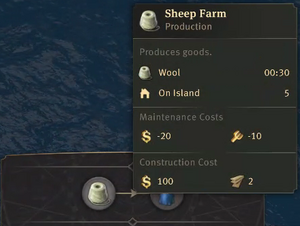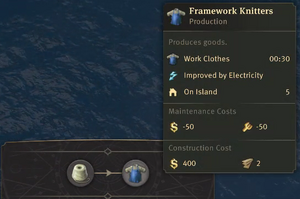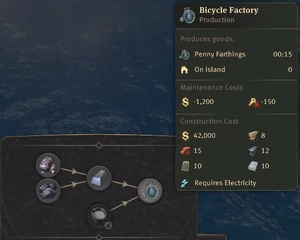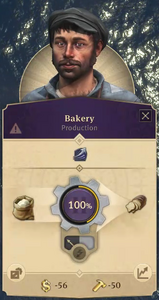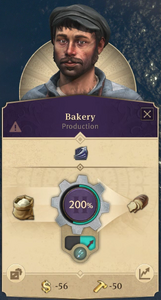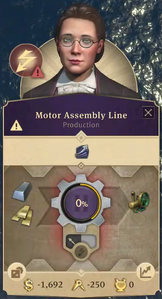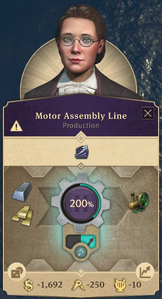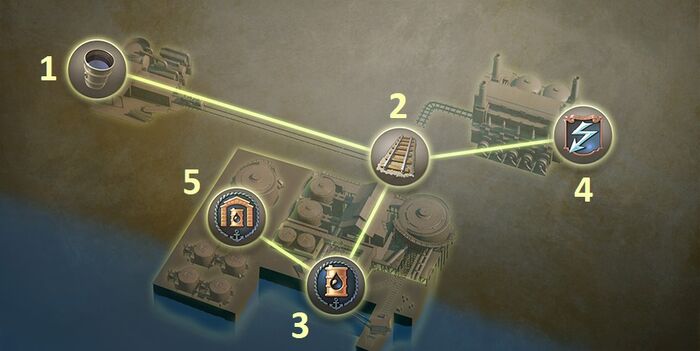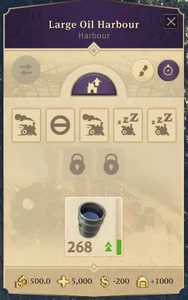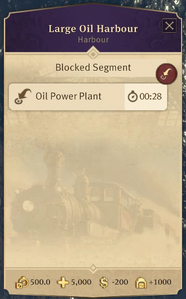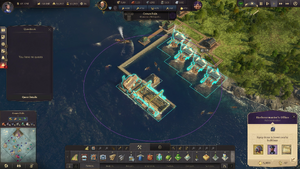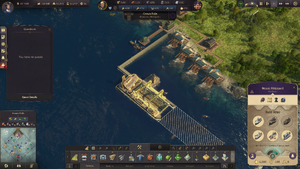Electricity is an important mechanic, available after reaching ![]() Engineers, and is required to fulfill the needs of some of the residents and required for some buildings to function. It can also be used to significantly improve various buildings' production rates. The main way of providing electricity to buildings is making sure they are within the range of an operational oil power plant (or power station), which has to be a part of a complex railway infrastructure. Such infrastructure includes an oil harbour, oil refineries and oil power plants – all connected via a railway system, which is used by trains to transport oil within the network to make sure oil power plants receive oil required to generate electricity. Other ways of providing electricity are items or gas-fired power plants (
Engineers, and is required to fulfill the needs of some of the residents and required for some buildings to function. It can also be used to significantly improve various buildings' production rates. The main way of providing electricity to buildings is making sure they are within the range of an operational oil power plant (or power station), which has to be a part of a complex railway infrastructure. Such infrastructure includes an oil harbour, oil refineries and oil power plants – all connected via a railway system, which is used by trains to transport oil within the network to make sure oil power plants receive oil required to generate electricity. Other ways of providing electricity are items or gas-fired power plants (![]() The Passage DLC), or the dam (
The Passage DLC), or the dam (![]() New World Rising DLC).
New World Rising DLC).
Usefulness[]
Electricity has several purposes and benefits. One of them is fulfilling a part of the population's basic need for electricity, which makes more people move into the residences. Another important use is improving production of goods, due to the fact that buildings get +100% productivity bonus when electrified. Some of those buildings require electricity to produce goods at all. There are also a few other buildings, such as World's Fair, which need electricity to function.
In the base game electricity and power plants are available only in the Old World (and Cape Trelawney). However, with ![]() New World Rising DLC it also becomes available in the New World. It is impossible to use electricity in Enbesa or The Arctic. Even items which provide electricity to buildings within the range of a trade union or harbourmaster's office do not provide such an effect in the regions where electricity is unavailable.
New World Rising DLC it also becomes available in the New World. It is impossible to use electricity in Enbesa or The Arctic. Even items which provide electricity to buildings within the range of a trade union or harbourmaster's office do not provide such an effect in the regions where electricity is unavailable.
Population's needs[]
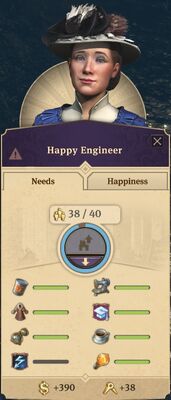
As indicated by the menu of an engineer residence, one of engineers' basic need is electricity – here it is the only unfulfilled basic need.
The following population tiers consider electricity as one of their basic needs:
 Engineers
Engineers Investors
Investors Scholars
Scholars Artistas who live in
Artistas who live in  Hacienda Artista Quarters
Hacienda Artista Quarters
Fulfilling that need provides no income (it does in case of Artistas) but increases the population count in each residence. The only way of providing electricity to residences is by having an active power plant nearby. A residence can either be within the range of an operational power plant, or not – which means that the need for electricity is either fully fulfilled or not fulfilled at all.
Goods production[]
Many buildings which produce goods can be affected by electricity which increases their productivity by +100%. Some of those buildings require electricity to be able to produce goods at all, when having electricity they operate with the same production time as indicated in the construction menu (this time already includes the productivity bonus). A lot of buildings can be improved by electricity, but they can produce goods even without it, though when provided with electricity they receive +100% bonus to their production rate.
To illustrate the difference between buildings which can be improved by electricity and buildings which require it, let's compare a concrete factory to a bicycle factory. A concrete factory produces 1 ton of reinforced concrete every minute and can be improved by electricity. When affected by electricity, its production rate is increased by 100%, and the factory can produce 1 ton of reinforced concrete in 30 seconds, which translates to 2 tons per minute. A bicycle factory produces 1 ton of penny farthings every 15 seconds, which translates to 4 tons per minute, and requires electricity. When unaffected by electricity, the factory does not produce anything at all. When affected by electricity, its production rate is equal to the rate displayed in the construction menu, which is 4 tons per minute. This production rate already involves +100% bonus, which means that 100% productivity of a bicycle factory corresponds to a production rate of 2 tons per minute.
Electrifying the industry greatly increases its efficiency, allows to obtain more goods from the same amount of factories and from the same amount of space. Improving the efficiency of factories allows to have less of them while still producing a lot of goods, which saves up workforce, space and income. For some production chains electricity may be necessary in order to turn high maintenance costs of the factories into income obtained from their products.
Another benefit from electrifying buildings which produce goods is that the logistics aspect also gets improved. When electrified, their horse carts turn into trucks which have higher speed on the roads and load and unload goods much quicker. Warehouses which accept carts from electrified buildings can handle many more factories than warehouses that take care of buildings without electricity. Therefore the industrial areas which are electrified require fewer warehouses.
Drastic increase of productivity, which comes with electricity, also has some downsides. Factories affected by electricity have much higher chances of fires and explosions. It is therefore recommended to place more fire stations within the electrified parts of the industry in comparison to unelectrified parts.
Workforce, income and space benefits[]
Due to the fact that electricity increases productivity of many buildings by +100%, providing them with electricity can significantly reduce the need for workforce and space, and maintenance costs.
Let's analyse a sewing machine factory as an example. One unelectrified sewing machine factory, normally turns 2 tons of ![]() wood and 2 tons of
wood and 2 tons of ![]() steel into 2 tons of
steel into 2 tons of ![]() sewing machines per minute. Its maintenance cost is -500 coins per minute and 150 artisan workforce, which means that producing 1 ton of sewing machines in an unelectrified factory costs 250 coins per minute and 75 artisan workforce. When electrified, one sewing machine factory turns 4 tons of
sewing machines per minute. Its maintenance cost is -500 coins per minute and 150 artisan workforce, which means that producing 1 ton of sewing machines in an unelectrified factory costs 250 coins per minute and 75 artisan workforce. When electrified, one sewing machine factory turns 4 tons of ![]() wood and 4 tons of
wood and 4 tons of ![]() steel into 4 tons of
steel into 4 tons of ![]() sewing machines per minute. Considering maintenance costs, producing 1 ton of sewing machines in an electrified factory costs 125 coins per minute and 37.5 artisan workforce. Therefore providing electricity to the sewing machine factory saves up half of the maintenance costs and workforce requirements, which would be necessary for the sewing machines production if no electricity was used.
sewing machines per minute. Considering maintenance costs, producing 1 ton of sewing machines in an electrified factory costs 125 coins per minute and 37.5 artisan workforce. Therefore providing electricity to the sewing machine factory saves up half of the maintenance costs and workforce requirements, which would be necessary for the sewing machines production if no electricity was used.
To produce 4 tons of sewing machines per minute, either one electrified factory is needed, or two unelectrified ones. In the first case it would cost 500 coins per minute and 150 artisan workforce, in the second case it would cost 1000 coins per minute and 300 artisan workforce. Besides money and workforce, space is another resource which gets saved up thanks to electricity, since the same production rate requires half as many factories. Having to build less factories also means that smaller amount of construction materials is required.
Many production buildings, especially from engineer and investor tiers, have high workforce and maintenance costs. Given how many factories can be electrified using only one source of electricity, providing electricity to production buildings can be extremely profitable. It can save many tons of construction materials, a lot of income, workforce and space.
Logistics improvements[]
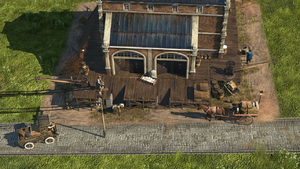
A warehouse which is going to accept two deliveries at the same time. From the left side (notice the electricity poles) comes a truck which originates from an electrified production building, its loading/unloading time will be only 2 seconds. From the right comes a horse cart originating from an unelectrified production, its loading/unloading will last for 20 seconds. Electricity significantly improves loading/unloading times of carts and therefore allows to decrease the number of required warehouses.
Buildings which take care of producing goods can benefit from electricity not only via increased productivity, but also via improvements to their logistics aspects. When electrified, the horse carts of buildings turn into trucks which have higher speed on the roads and load and unload goods much quicker. Horse carts take 20 seconds when loading/unloading goods at warehouses, while trucks take only 2 seconds. It means that warehouses which accept carts from electrified buildings can handle many more factories than warehouses that take care of buildings without electricity. Therefore the industrial areas which are electrified require fewer warehouses. The location of the warehouses does not matter, what matters is the fact whether a factory is electrified or not.
Additionally, electricity allows buildings to receive an additional cart, or in the case of electrified buildings an additional truck. Every time the productivity increases above the next threshold, the building receives another cart, which can be used to fetch or deliver goods. The thresholds are located at every 100% increase of productivity. For example a building at 100% productivity has 1 cart, but as soon as the productivity reaches 101%, it receives another cart and has 2 carts in total. At 200% productivity the building still has 2 carts, as soon as the productivity reaches 201% or more, it gets another cart, having 3 carts in total. Electricity increases productivity by +100% meaning that it always makes the building pass the threshold and thus grants 1 additional cart for electrifying the building.
Which buildings can be affected[]
Once the first engineer residence is obtained, the construction menu and buildings' menus start indicating whether a building can be improved by electricity or requires electricity:
- In the construction menu when hovering over a specific building, its infotip will show whether it can be improved by electricity or requires electricity. Lack of information about electricity means that the building cannot benefit from electricity.
- The building's menu of production buildings may include an electricity gauge below the cog referring to the building's productivity. If the electricity gauge is displayed, the building can be electrified. Without electricity the gauge's pointer is turned to the left side, the gauge's area is gray and the electricity symbol is dark. When electricity is provided to the building, the pointer is turned to the right, the right side of the gauge's area becomes blue, electricity symbol is bright blue and the production process meter is blue instead of yellow.
There is a simple rule which can help remember which buildings can be affected by electricity without looking into their menus or the construction menu. Pretty much all Old World production buildings can benefit from electricity, except crop farms, animal farms, fisheries, lumberjack's huts, hunting cabins and oil refineries. Another way to look at this is by which type of workforce is needed. All buildings which require workers (except oil refineries), artisans and engineers can be affected by electricity. Most of the buildings which employ farmers cannot benefit from electricity, except buildings which require input such as framework knitters. Fisheries on the other hand, do not require any input and therefore cannot be affected by electricity.
Which production requires electricity[]
Certain buildings which produce goods require electricity to function. Without power, these buildings and their production chains will not work at all. These buildings are:
 Heavy Weapons Factory
Heavy Weapons Factory Bicycle Factory
Bicycle Factory Motor Assembly Line
Motor Assembly Line Clockmakers
Clockmakers Gramophone Factory
Gramophone Factory Cab Assembly Line
Cab Assembly Line Telephone Manufacturer (
Telephone Manufacturer ( Land of Lions)
Land of Lions) Advanced Coffee Roaster (
Advanced Coffee Roaster ( Land of Lions)
Land of Lions) Advanced Rum Distillery (
Advanced Rum Distillery ( Land of Lions)
Land of Lions) Advanced Cotton Mill (
Advanced Cotton Mill ( Land of Lions)
Land of Lions) Assembly Line (
Assembly Line ( The High Life)
The High Life) Motor Assembly Plant (
Motor Assembly Plant ( New World Rising)
New World Rising) Fan Factory (
Fan Factory ( New World Rising)
New World Rising) Scooter Factory (
Scooter Factory ( New World Rising)
New World Rising)
Production of secondary goods[]
With ![]() New World Rising DLC animal farms in the New World can receive unique benefits from having access to electricity. When the main building of an animal farm is electrified, the pastures of the farm produce secondary goods in addition to the farm producing its regular output as usual. The pastures do not need any road connection and when each production cycle is finished, the goods they produce are automatically added to the island's storage, without any need for carts or warehouses. Electricity does not affect the main production of animal farms, their productivity remains the same and they still use horse carts.
New World Rising DLC animal farms in the New World can receive unique benefits from having access to electricity. When the main building of an animal farm is electrified, the pastures of the farm produce secondary goods in addition to the farm producing its regular output as usual. The pastures do not need any road connection and when each production cycle is finished, the goods they produce are automatically added to the island's storage, without any need for carts or warehouses. Electricity does not affect the main production of animal farms, their productivity remains the same and they still use horse carts.
When the production of the main building is paused, the production of the pastures also gets paused. On the other hand, each pasture can be paused without affecting the main production. Additionally, any lack of workforce affects only the main production and not the secondary production. Similarly, if the main building stops production due to its output storage being full, the pastures can still produce secondary goods.
With electricity the New World animal farms make the following secondary products:
 Alpaca Farm - its modules produce
Alpaca Farm - its modules produce  Saltpetre with the production time of 04:00. It is equal to 0.25 tons of saltpetre per minute per module or 1 ton per minute from an entire alpaca farm.
Saltpetre with the production time of 04:00. It is equal to 0.25 tons of saltpetre per minute per module or 1 ton per minute from an entire alpaca farm. Cattle Farm - its modules produce
Cattle Farm - its modules produce  Milk with the production time of 01:00. It is equal to 1 ton of milk per minute per module or 6 tons per minute from an entire cattle farm.
Milk with the production time of 01:00. It is equal to 1 ton of milk per minute per module or 6 tons per minute from an entire cattle farm. Nandu Farm - its modules produce
Nandu Farm - its modules produce  Nandu Feathers with the production time of 02:00. It is equal to 0.5 tons of nandu feathers per minute per module or 2 tons per minute from an entire nandu farm.
Nandu Feathers with the production time of 02:00. It is equal to 0.5 tons of nandu feathers per minute per module or 2 tons per minute from an entire nandu farm.
Other uses[]
Besides fulfilling population's need for electricity and helping with goods production, several other buildings also require electricity to perform their basic functions. Those buildings are:
 Steam Shipyard
Steam Shipyard World's Fair
World's Fair Research Institute (
Research Institute ( Land of Lions)
Land of Lions) The Iron Tower (
The Iron Tower ( Tourist Season)
Tourist Season) Department Store (
Department Store ( The High Life)
The High Life) Furniture Store (
Furniture Store ( The High Life)
The High Life) Drug Store (
Drug Store ( The High Life)
The High Life) Grand Stadium (
Grand Stadium ( New World Rising)
New World Rising)
Additionally, while ![]() Sailing Shipyard does not require electricity, it can be improved by electricity, which halves the construction time of sailing ships.
Sailing Shipyard does not require electricity, it can be improved by electricity, which halves the construction time of sailing ships.
Oil[]
Generating electricity using oil is the main way of providing electricity to buildings. Using oil power plants requires establishing a unique system of several buildings, tied together by a railway network and involving a special type of ships. This system consists of the following elements:
- Oil Refinery – its role is to produce oil, it has to be placed nearby oil springs, where oil wells can be constructed. The more oil wells around a refinery, the higher its productivity is.
- Railway – the railway creates space on which the trains can travel. The trains' only purpose is transporting oil between different parts of the oil system.
- Oil Harbour – building which stores oil and provides trains for the railway network. Only one oil harbour can be built on an island, this building is absolutely required to produce or use oil on any island.
- Oil Power Plant – a power plant which burns oil to generate electricity. They use engineer workforce and provide electricity to buildings in the range, based on the road distance. With
 New World Rising DLC a New World version is available - the Power Station which uses obrero workforce.
New World Rising DLC a New World version is available - the Power Station which uses obrero workforce. - Oil Store – an optional building which increases the amount of oil that can be stored in the oil harbour.
- Oil Tanker – special type of ship which can be used to transport oil between oil harbours of different islands. They can be constructed at steam shipyards, which require electricity.
Oil Refinery[]
For more information, see: Oil Refinery, and Oil
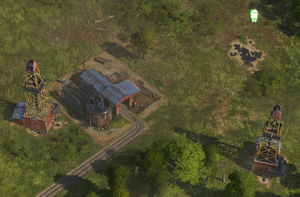
An oil refinery with two oil wells and one unexploited oil spring within refinery's range. The refinery is connected to railway which leads to the oil harbour
Oil refinery is a production building which produces oil from oil wells built on oil springs located within the refinery's range. Oil springs are located in small numbers on 'main islands' in Old World and Cape Trelawney, and in substantial numbers on majority of islands in New World. To produce oil from them, an oil refinery has to be built nearby oil springs, and oil wells have to constructed on top of the oil springs.
To add the oil produced in the oil refinery to the island's oil storage, it has to be collected and transported by trains from the refinery to the oil harbour. To allow trains to access the refinery, it has to be connected via railway to the oil harbour. Refineries have two spots on opposite sides in the middle of the building, where rails can be attached to the refinery. The railway has to be connected only to one of the two entrances, trains can enter the railway and then leave it with oil using the same entrance and the same railway. If the refinery is connected on both sides, the trains are able to enter the refinery from either side, and then leave on the other. When building the railway, the entrances to the refinery are gently highlighted.
Without any modifiers, each oil well contributes 4 tons of oil per minute to the refinery's productivity, and 3 wells are required to continuously provide enough oil for one oil power plant. There is no limit with regards to how many oil wells can belong to a single refinery or to the productivity of a refinery. The efficiency of oil refineries can also be modified with trade union items or via working conditions. However, the internal storage of each refinery is limited and at some point trains might not keep up with extremely high production anymore. In addition, increased productivity may drastically increase the chances of fires and explosions at the refineries.
Alternative oil sources[]
Oil can also be obtained without oil refineries by using a legendary item which affects mines and quarries. Oil produced this way appears in the oil harbour's storage automatically and does not require to be transported to the harbour by railway.
Legendary | ||
|---|---|---|
| Jörg always seems to be first on the scene before the gold rush begins in earnest. Has the heart of cousin Carl. | ||
Affects All Mines and Quarries |
Effects Productivity: +70% Extra Goods Occasionally produces extra Occasionally produces extra |
Expedition Bonus |
Railway[]
For more information, see: Railway
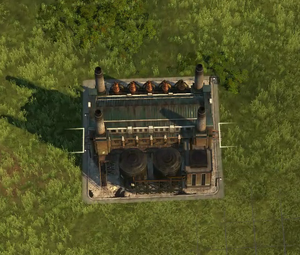
When constructing railway, the spots where a building needs to be connected to railway are highlighted
Oil can be transported within an island only by trains, which require a railway system. Railway has to connect oil refineries and oil power plants to the oil harbour. Every building which can be connected to the railway system has at least one tile within the building where railway has to be attached to. The building is connected to the network only when the rails lead to this particular tile of the building. When placing rails, those connection spots are gently highlighted. Buildings built on land have two such spots on opposite sides of the building. It is enough if only one of them connects to the railway network. If both are connected, trains can go through the building or can enter them on one side and leave on the other side.
Trains can start travelling across the railway network as soon as the network is connected to the oil harbour and there is at least one other building connected. The trains are provided by the oil harbour, they do not have to be constructed or maintained. There is a limit of how many trains are available, based on the upgrade level of the oil harbour. Trains seem to be able to carry unlimited amount of oil, with trains getting longer the more oil they transport.
Trains start their journey from the oil harbour, from which they might collect some oil. Then they travel to their destination at a steady pace. They never slow down even when approaching or going through a road-railway crossing, going through any road traffic they may encounter – it does not cause any incidents whatsoever. When trains reach an oil refinery or oil power plant, the entire train will enter the building, then spend some time loading/unloading oil. After that the train leaves the building and proceeds to the next destination or goes back to the oil harbour.
However, trains cannot go through each other and when a train is travelling across a railway track, the entire track or its segment might be blocked, preventing other trains from using the blocked segment. Trains can travel on the same track in the same direction but not in opposite directions. Multiple trains can be within the same building at the same time, when one train is already loading/unloading oil in a refinery or a power plant, another train can enter the same building. To leave a building, the trains need an unoccupied railway route leading to their destination. If all possible paths are blocked, the train waits within the building until its path is clear.
Railway layout[]

There are two railway tracks on both sides of a river, connected by a single bridge. If one train starts the journey from the left side and will cross the bridge after a minute, a second train can start its journey from the right side if it will be able to cross the bridge and switch tracks before the first train arrives to the bridge section.
Rails need to start at the oil harbour and have to go throughout the island to oil power plants located within the cities or to oil refineries within the oil deposits area. Because of that, the rails might have to stretch across the whole island and go through the cities, farms or industrial areas. It is important to consider the layout of the railway network to ensure that the railway can reach all appropriate buildings and that trains would not have any major problems with transporting oil. Especially if there are many buildings within the network and if some of them are far away from the oil harbour, it is necessary to ensure that railway tracks rarely get blocked and trains can deliver oil on time – so that oil refineries do not get full and that oil power plants do not run out of oil.
To check and monitor the train congestion, select the oil harbour, upon which the blocked tracks are highlighted in red. There are several ways of ensuring that railway tracks do not get blocked too often and that trains can freely travel across the network:
- Dividing the network into several segments
- Creating parallel tracks
- Using both exits of buildings and connecting them in a loop
Oil harbour has only one entrance for the trains where the railway has to be connected. Therefore if many trains are needed to service the oil network and the solution is to split the railway network into several tracks, it is best to do so as close to the oil harbour as possible.

The picture shows the same locations but in two different versions. On the left there is a single main track and one track to the power plant. The train coming from the left side is going from an oil refinery to the oil harbour located towards the right side. A train which is supposed to deliver oil from the harbour to the power plant is delayed because of the single track being occupied by the train. On the right side there are two main tracks and both of them connect to two side tracks leading to the power plant. It is easier for trains to travel from the refinery to the oil harbour and from the oil harbour to the power plant at the same time.
Oil Harbour[]
For more information, see: Oil Harbour
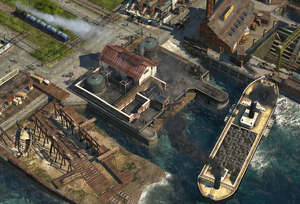
An oil harbour with railway connected to it and an oil tanker loading or unloading oil at the harbour. Notice that the railway is split into two tracks very close to the oil harbour.
Oil Harbour is a crucial part of the oil system, it stores oil, provides trains for the railway network and allows oil tankers to load/unload oil. Only one oil harbour can be built on an island, and constructing it is necessary to make the oil system work. Oil harbour is the only source of trains, and this is the building where trains start and end their journeys at. The number of available trains is limited but the oil harbour can be upgraded to increase that limit (from 3 to 7 trains). Upgrades also increase how much oil can be stored on the island.
Transporting oil between islands requires oil tankers and the only building which allows oil tankers to load/unload oil is the oil harbour. Oil tankers cannot use trading posts or piers. It should not cause any major problems though, given that oil harbours, regardless of their level, have very high loading speed.
Oil Power Plants[]
For more information, see: Oil Power Plant or Power Station
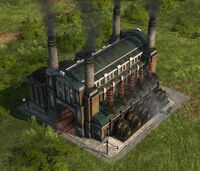
An oil power plant without any railway connection.
Oil Power Plants (and Power Stations) are a source of electricity to nearby buildings, as long as the power plants have steady supply of oil and enough engineer (obrero) workforce. There are two tiles within the oil power plant where the railway can be connected to, they are located on two opposite sides of the building, one tile on each side. Railway has to be connected to at least one of them and has to lead to the oil harbour to allow trains to deliver oil to the power plants. Oil power plants consume 12 tons of oil per minute, and have a limited oil storage, therefore regular deliveries of oil are necessary. Utilising 3 oil springs at default productivity can provide enough oil for one power plant.
Electricity is provided via the roads based on road distance between a building and a power plant, in the same way as public buildings function. The only major differences are that power plants' range has no gradation, they either fully provide electricity or provide no electricity at all, and to provide electricity they need to have workforce and oil. It is enough if a building is adjacent to just one tile of road that is within a power plant's range – if the power plant is operational the building will have access to electricity. Select any power plant to see the combined range of all power plants on the island – the road tiles within the range get highlighted in green. Additionally, electricity poles are visible on all roads within the range of power plants – however, the electricity poles can be disabled in gameplay settings.

Selecting a power plant highlights all roads within the range of power plants in green colour. There are also electricity poles stretched across those parts of the roads.
Oil Stores[]
For more information, see: Oil Store
Oil Stores are an entirely optional compontent of the oil system. Upgrading the oil harbour increases the oil storage capacity but it has its final limit at the highest level. Oil stores can increase the storage capacity for oil even further. They have to be placed within a free harbour area of the island but they do not have to be near the oil harbour, they can be located anywhere within the island's harbour.
Oil Tanker[]
For more information, see: Oil Tanker
Oil Tankers are the only ships which are able to carry oil, and they are necessary to transport oil between different islands. They cannot use items or carry any other goods than oil. They can be used on oil routes, a special type of trade routes, which are used exclusively for continuous transports of oil.
To obtain oil tankers, they have to be constructed at a steam shipyard or bought from a neutral trader who offers them for sale. However, the steam shipyard and motor assembly line both require electricity. Therefore in order to construct the first oil tanker, it is necessary to already be able to provide electricity in the first place. It is recommended to initially use the oil springs already available on one of the four main islands in Old World and to prioritise electrifying a motor assembly line and a steam shipyard. This is to ensure that it is possible to build oil tankers to bring more oil from other islands. However, as Sir Archibald Blake who is always present in the game can sell oil tankers, following such a strategy is not necessary.
Arctic Gas[]
Using gas-fired power plants is an alternative way of generating electricity in the Old World (and Cape Trelawney), available only with ![]() The Passage DLC. Gas-fired power plants require settling in The Arctic, expanding to the high glacier plateaus, and setting up some expensive infrastructure. Generating electricity from arctic gas involves the following:
The Passage DLC. Gas-fired power plants require settling in The Arctic, expanding to the high glacier plateaus, and setting up some expensive infrastructure. Generating electricity from arctic gas involves the following:
- Arctic Gas Mine – its role is to produce arctic gas, it has to be placed nearby gas deposits, where gas pumps can be constructed. The more gas pumps around a mine, the higher its productivity is.
- Airship – airships are necessary to establish and sustain the arctic gas production, and to transport arctic gas to Old World
- Trading Post or Pier – arctic gas has to be transported from The Arctic to Old World and a trading post or a pier is required to allow for unloading arctic gas
- Gas-Fired Power Plant – a power plant which burns arctic gas to generate electricity. They use engineer workforce and provide electricity bo buildings in the range, based on the road distance.
- Warehouse – it is necessary to have a warehouse or a trading post within the range of the power plant so that arctic gas can be transported from island's storage to the power plants
Arctic Gas production[]
For more information, see: Arctic Gas Mine, and Arctic Gas
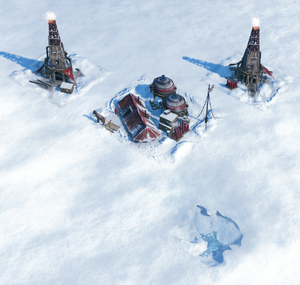
An arctic gas mine with two gas pumps and one unexploited gas deposit within the mine's range. This mine, however, lacks access to heating and to a warehouse where it could deliver produced arctic gas to.
Arctic Gas Mine is a production building which produces arctic gas from gas pumps built on gas deposits located within the mine's range. Gas deposits are located only on four glacier plateau islands in the Arctic, 13 deposits on each island, 52 deposits in total. Plateaus always look the same and have the same placement of gas deposits, regardless of game settings. To produce arctic gas from the deposits, an arctic gas mine has to be built near the deposits and gas pumps have to be constructed on top of them. Arctic gas mines have their own carts which are used to deliver arctic gas to the sky trading post or warehouses within the mines' range.
Without any modifiers each gas pump contributes 2/9 (or about 0.22) tons of arctic gas per minute to the arctic gas mine's productivity, 6 gas pumps are required to continuously provide enough arctic gas for one gas-fired power plant. There is no limit with regards to the productivity of a mine or to how many gas pumps can belong to a single mine (though due to how islands have been designed, no more than 4 deposits can ever be located within the range of one arctic gas mine). The efficiency of arctic gas mines can be modified with arctic lodge items. Increased productivity may drastically increase the chances of fires and explosions at the arctic gas mines.
Setting up[]
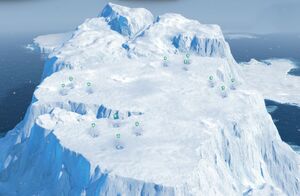
One of the glacier plateaus in The Arctic. They can be accessed only by airships and their only natural resource is arctic gas, spread between 13 deposits split into 4 groups.
Preparing the arctic gas production is probably the most challenging part of using arctic gas as the electricity source. Gas deposits are available only on glacier plateaus in The Arctic, which have no fertilities and cannot be accessed by any ships other than airships. Arctic gas production requires technician workforce which can be provided only via technician shelters. All of that makes extracting arctic gas somewhat difficult, and it requires time and effort to set everything up.
First, airships are required in order to even settle on the plateaus. To construct the first airship, it is necessary to build settlements on regular islands in The Arctic, provide basic needs for the population, follow the quests from Lady Faithful (not applicable when playing in multiplayer) and advance explorers to technicians. Then construction of an airship hangar can start, it requires explorers and technicians workforce and various construction materials, some of which have to be shipped in from Old World. Once the airship hangar is ready and Old Nate gifts some arctic gas, it is possible to construct the first airship. Loading the airship with timber and steel beams and flying it over the plateaus allows to claim them and build a sky trading post on top of each plateau.
After claiming a plateau the next step is to build a settlement on top of it. Except goose feathers and huskies, nothing can be produced on the plateaus without delivering goods to them from other islands. Therefore airships have to be used to deliver goods that explorers and technicians require. As usually, it can be done either manually or automatically via trade routes that use airships. After upgrading your population to have enough technicians, all that is left is to construct arctic gas mines and gas pumps, and ensure that there is a warehouse or sky trading post within arctic gas mine's range. Remember that arctic gas mines also require heating so they need to be in range of at least one operational heater.
Transportation[]
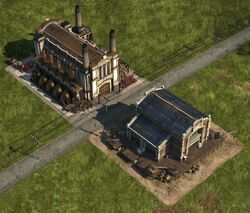
Using arctic gas-based electricity in the Old World is simple: a gas-fired power plant, a warehouse and roads. No railway or other special components are required.
Unlike oil which needs a separate delivery system including oil tankers, oil harbour and railway, transporting arctic gas is the same as in case of the majority of goods. Arctic gas produced in arctic gas mines is taken by carts to the sky trading post or warehouses, thus being added to the island's storage. Using airships, arctic gas can be delivered from plateaus to other islands, then it can also be moved between islands by regular ships. Once delivered to an island with a gas-fired power plant, the plant will send carts to trading posts or warehouses to bring arctic gas to the power plant.
Gas-Fired Power Plant[]
For more information, see: Gas-Fired Power Plant
Gas-Fired Power Plants are a source of electricity to nearby buildings, as long as the power plants have steady supply of arctic gas and enough engineer workforce. Arctic gas is delivered by each plant's carts from trading posts or warehouses located within their range. Gas-fired power plants consume 4/3 (about 1.33) tons of arctic gas per minute. Utilising 6 gas deposits at default productivity can provide enough arctic gas for one power plant.
Electricity is provided via the roads based on road distance between a building and a power plant, in the same way as public buildings function. The only major differences are that power plants' range has no gradation, they either fully provide electricity or provide no electricity at all, and to provide electricity they need to have workforce and arctic gas. It is enough if a building is adjacent to just one tile of road that is within a power plant's range – if the power plant is operational the building will have access to electricity. Select any power plant to see the combined range of all power plants on the island – the road tiles within the range get highlighted in green. Additionally, electricity poles are visible on all roads within the range of power plants – however, the electricity poles can be disabled in gameplay settings.
Items[]
Items equipped in trade unions or harbourmaster's offices can be another source of electricity. An appropriate item has to be equipped and then it will provide electricity to appropriate buildings within the range of the administration building. However, using items as a source of electricity has certain limitations:
- It requires influence and the area of effect is limited to the radius of the trade union or harbourmaster's office
- Only production buildings can be affected. There are no items which can provide electricity to buildings such as residences, multifactories or monuments.
- Production buildings which cannot be electrified by power plants are also unaffected by the items' electricity effect (other effects of those items may still be applied though)
Trade Union[]
The following items can provide electricity to buildings when equipped in trade unions:
Uncommon | ||
|---|---|---|
| A volatile source of electric power. | ||
Affects All Production Buildings |
Effects Maintenance Cost: +100% Explosion Chance: +70% Provides electricity |
Expedition Bonus |
| This item can provide electricity only to buildings that can normally be affected by power plants | ||
Rare DLC Required
Sunken Treasures | ||
|---|---|---|
| So the blue cable to the yellow pin... Oh wait... Or was it red? | ||
Affects |
Effects Chance of Fire: +150% Explosion Chance: +70% Provides electricity |
Crafting Cost |
| This item can provide electricity only to buildings that can normally be affected by power plants Source: crafting at Old Nate's workshop in Cape Trelawney | ||
Rare | ||
|---|---|---|
| A safe source of electric power. | ||
Affects All Production Buildings |
Effects Maintenance Cost: +75% Explosion Chance: +50% Provides electricity |
Expedition Bonus |
| This item can provide electricity only to buildings that can normally be affected by power plants | ||
Epic | ||
|---|---|---|
| Bill busts his chops to produce the stoutest of porterhouse stouts. | ||
Affects |
Effects Chance of Riots: -100% Provides electricity |
Expedition Bonus |
Epic | ||
|---|---|---|
| Ferhat brings something fundamentally different to the mix. | ||
Affects |
Effects Productivity: +40% Provides electricity |
Expedition Bonus |
| This item can provide electricity only to buildings that can normally be affected by power plants | ||
Epic | ||
|---|---|---|
| To him, the igneous strata appear as musical notation, whistling the melody of the ages. | ||
Affects |
Effects Extra Goods Occasionally produces extra Provides electricity |
Expedition Bonus |
Epic | ||
|---|---|---|
| A highly-efficient and safe source of electrical power! | ||
Affects All Production Buildings |
Effects Maintenance Cost: +50% Provides electricity |
Expedition Bonus |
| This item can provide electricity only to buildings that can normally be affected by power plants | ||
Epic DLC Required
Sunken Treasures | ||
|---|---|---|
| The persistent screech this extra-powerful contraption generates cannot be normal... | ||
Affects |
Effects Chance of Fire: +100% Explosion Chance: +50% Provides electricity |
Crafting Cost |
| Source: crafting at Old Nate's workshop in Cape Trelawney | ||
Legendary | ||
|---|---|---|
| Angela has an astonishing intellect, but it's her capacity to improvise that makes her really sparkle. | ||
Affects All Production Buildings |
Effects Workforce Needed: -20% Provides electricity |
Expedition Bonus Trait: Diver |
| This item can provide electricity only to buildings that can normally be affected by power plants | ||
Legendary | ||
|---|---|---|
| Conducts lightning. His family (from Wittenberg) has the motto, "standing still is a backward step." | ||
Affects |
Effects Productivity: +50% Extra Goods Occasionally produces extra Occasionally produces extra Occasionally produces extra Occasionally produces extra Occasionally produces extra Provides electricity |
Expedition Bonus |
Legendary | ||
|---|---|---|
| For Papadikas, the pain of experimentation is worthwhile. He hopes his windows shall be looked at, as well as looked through. | ||
Affects |
Effects Productivity: +50% Extra Goods Occasionally produces extra Provides electricity |
Expedition Bonus |
| This item can provide electricity only to buildings that can normally be affected by power plants | ||
Legendary DLC Required
Sunken Treasures | ||
|---|---|---|
| The enthusiast's choice. Old Nate neglected to include an operating manual, meaning there's a chance of the odd accident. | ||
Affects |
Effects Chance of Fire: +50% Explosion Chance: +30% Provides electricity |
Crafting Cost |
| Source: crafting at Old Nate's workshop in Cape Trelawney | ||
Harbourmaster's Office[]
The following items can provide electricity to buildings when equipped in harbourmaster's offices:
Rare DLC Required
Sunken Treasures | ||
|---|---|---|
| Clever use of water's potential energy to generate electricity. | ||
Affects |
Effects Chance of Fire: +150% Explosion Chance: +70% Provides electricity |
Crafting Cost |
| This item can provide electricity only to buildings that can normally be affected by power plants Source: crafting at Old Nate's workshop in Cape Trelawney | ||
Epic DLC Required
Sunken Treasures | ||
|---|---|---|
| This advanced hydroelectric paddlewheel is immune to rust and corrosion, if not the odd explosion. | ||
Affects |
Effects Chance of Fire: +100% Explosion Chance: +50% Provides electricity |
Crafting Cost |
| This item can provide electricity only to buildings that can normally be affected by power plants Source: crafting at Old Nate's workshop in Cape Trelawney | ||
Legendary DLC Required
Sunken Treasures | ||
|---|---|---|
| This unique hydroelectric generator has a gold plaque inscribed with its inventor's motto: "Consequences be dammed! Ha! — N8" | ||
Affects |
Effects Chance of Fire: +50% Explosion Chance: +30% Provides electricity |
Crafting Cost |
| This item can provide electricity only to buildings that can normally be affected by power plants Source: crafting at Old Nate's workshop in Cape Trelawney | ||
Generating electricity – comparison[]
Each of the three main methods of generating electricity has its advantages and disadvantages, and in specific situations some may be better than others. In general however, oil power plants should be the main source of electricity, while gas-fired power plants and items should be supplementary. The following table provides a quick comparison of the electricity sources, below the table there is a more detailed comparison of every important factor.
| Oil Power Plants (Power Stations) |
Gas-Fired Power Plants | Items | |
|---|---|---|---|
| Amount of space needed in the Old World | High | Low | Medium |
| Effort required to set up the system | Medium | Very high | Varied |
| Limitations | Trains and railway layout are the only real limit | Very low amount of gas-fired power plants is possible | Influence is a limiting factor Cannot provide electricity to all types of buildings |
| Maintenance costs | Medium | Very high | Low |
| Workforce needed | engineers and workers or obreros | engineers and technicians | none |
Regarding how much space is used in Old World, utilising oil power plants requires the most space, considering the involvement of railway and potentially also the oil refineries. A significant part of the harbour area may also be occupied, if many oil stores are required. In case of arctic gas less space is required. Even though the gas-fired power plants are slightly larger than oil ones and they require warehouses, their range is larger and no railway is necessary. In case of items only the administration buildings are involved, and they do not occupy a lot of space. However, given much smaller range of those buildings in comparison to power plants, the space required to electrify the same number of buildings is actually larger than space occupied by the infrastructure for gas-fired power plants.
Each way of generating electricity requires some effort to set it up. Main challenge and effort of oil is setting up the railway network, integrating it into the cities and making sure its layout is good enough to ensure smooth train travels. Creating first network can be somewhat difficult, especially if the city was unprepared for including railway, but in the long run the effort is moderate. Much more difficult to set up is the arctic gas production for gas-fired power plants – it involves settling in The Arctic which is a tough region to handle anyway, constructing airships and settling, and supplying the plateaus. The effort required to use items as source of electricity can vary, mostly depending on obtaining appropriate items which often has to do with luck and RNG. It also involves constructing as many buildings within a trade union's or harbourmaster's office's radius as possible.
Each method also has its limitations. Oil as the main source is the least limited. While oil springs are limited, there are plenty of them in New World and trade unions and working conditions can be used to significantly increase their productivity. The biggest limitation is actually how many power plants your railway networks can handle. Arctic gas, on the other hand, is very limited, each of the 4 plateaus has only 13 deposits, and 6 are needed per power plant. There are very few ways of improving arctic gas production too. Without improvements it is possible to have only up to 8 gas-fired power plants. In case of items the biggest limitation is that they can be used only for production buildings. Residences and some other types of buildings cannot be provided with electricity via items. Other limitations are influence points and the number of items which can provide electricity that you manage to acquire.
The maintenance and workforce costs are the highest when generating electricity using arctic gas. Gas-fired power plants and arctic gas mines require engineers and technicians workforce, respectively, and both have high maintenance costs. Needing airships to supply plateaus and fetch arctic gas also significantly increases maintenance costs. Using oil requires engineers and workers or obreros workforce, which are easier to supply than technicians. Oil power plants, oil refineries and oil tankers have much lower maintenance costs, though still significant. Using items does not require any workforce at all, and maintenance costs of trade unions and harbourmaster's offices are extremely low in comparison to using arctic gas or oil. The only real cost is the influence cost, which can add up to very high numbers if an area serviced by a power plant was to be serviced by multiple trade unions instead.
Overall, using oil should be the main source of electricity due to its lack of significant limitations and its costs and difficulty being moderate and reasonable. Since arctic gas is very limited, the location of gas-fired power plants should be carefully planned. They are best used mainly in places where too many oil power plants would put too much strain on the railway network. Considering the high maintenance costs, make sure you can afford using gas-fired power plants before starting to invest into arctic gas production. As items can be used only for production buildings, this source of electricity should be used only in locations which are filled with production buildings and where using power plants could be inconvenient. For example, using a power plant on a very small island may require more effort than it is actually worth it, and only a part of its range would be actually utilised. In such cases using items may be much more convenient and profitable.
Dam[]
For more information, see: Dam
Using the dam is a unique way of generating electricity on Manola, the continental island in the New World, available only with ![]() New World Rising DLC. It is a monumental building, constructed in several phases. When it is completed, it generates electricity without any input, only enough obrero workforce is required. Like in case of other power plants, electricity is provided via the roads based on the road distance between a building and the dam. It has a much higher street range in comparison to power stations, with appropriate street system it can provide electricity to almost entire Manola. Therefore building power stations might be unnecessary on that island, but since the dam is not available anywhere else, all other New World islands have to use power stations or items to provide electricity to buildings.
New World Rising DLC. It is a monumental building, constructed in several phases. When it is completed, it generates electricity without any input, only enough obrero workforce is required. Like in case of other power plants, electricity is provided via the roads based on the road distance between a building and the dam. It has a much higher street range in comparison to power stations, with appropriate street system it can provide electricity to almost entire Manola. Therefore building power stations might be unnecessary on that island, but since the dam is not available anywhere else, all other New World islands have to use power stations or items to provide electricity to buildings.

